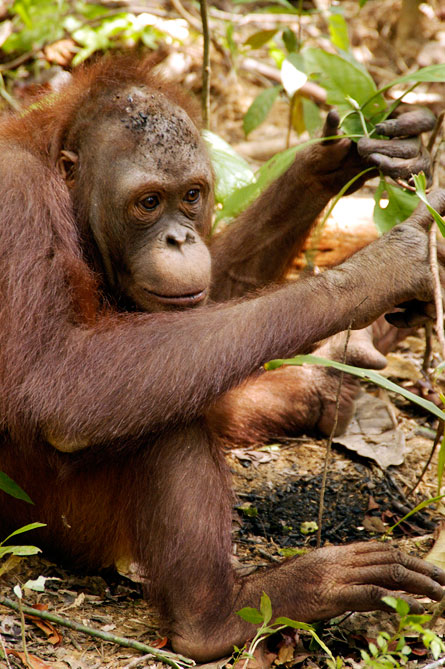
Orangutans have repeatedly demonstrated the capacity to communicate by pantomiming, researchers say, usually when some dim-witted human just hasn’t gotten the message.
Combing through about 20 years of observations in Indonesia, two researchers highlight 18 occasions of what they interpret as orangutans acting out some request or other communication in elaborated gestures of pantomime. The observations may offer insight into what orangutans understand about the minds of others and also shed light on the ancient gestural roots of human language.
On four of the occasions, one orangutan mimed for another and on 14 an orangutan mimed to a human, according to a paper released online the week of August 9 in Biology Letters.
For example, orangutans being rehabilitated into free-living forest life at a facility on Borneo sometimes get dirt scrubbed off their faces by a person with a leaf, says study coauthor and cognitive ecologist Anne Russon of York University in Toronto. So, she says, she did know what was going on when a young male called Cecep plopped down in front of her and handed her a leaf.
“I played dumb,” she remembers. “He waited a respectable few seconds, then — all the while looking me in the eye — he took back the leaf, rubbed it on his own forehead….” Again he handed it to her. “Then I did as I was told,” she says, and wiped away the dirt.
Orangutan-to-human pantomimes may be the easiest to observe, Russon says, but these are also occasions that present special challenges to communication, and possibly to patience. “The orangutans get a look on their faces like ‘Are you stupid?’” she says.
In another sequence, caught on video, Russon says a young female orangutan called Siti swiftly punched though one of a coconut’s three eyelike depressions and broke off a leaf stem to fish out the sweet innards. When Siti had exhausted what she could reach through that opening, she took her coconut to one of the men at the rehabilitation forest. On occasion he did whack open coconuts with his big parang knife, but was supposed to be encouraging forest residents to do such chores for themselves. He handed the nut back to Siti.
She “briefly and weakly poked into the coconut opening” and then handed it back to the human. “Sooo pathetic!” Russon says to describe Siti’s exaggerated air of exhaustion with the task. When the man again did nothing, Siti took her leaf stem and made chopping-style slashes against the coconut, in what looked to Russon like mimicry of a person using a parang.
“I must say that I have never heard this called pantomime before,” says Frans de Waal of Emory University’s Yerkes National Primate Research Center in Atlanta. Primate observers, including de Waal, have documented iconic gestures before, such as those that reenact something that apes want done. The new paper ranks, he says, “as a nice addition with regards to orangutans.”
One of the themes in 13 of Russon’s examples is the mimer’s elaboration of a breakdown in communications. This “suggests they understand something about what their partner didn’t understand,” she says.
Studying mime offers a way to look at long-standing issues of nonhuman species’ theories of mind. Pantomime gestures also present a way to look at the deep evolutionary origins of human language, Russon says. Recent thinking has raised the possibility that language sprouted from gestural communication. And she argues that orangutans can be eloquent gesturers, even if it’s only about dirty fur.
A young orangutan pantomimes for help with a coconut//vimeo.com/14061453″> from Science Science News//vimeo.com/sciencenews”> on Vimeo. //vimeo.com”>
Young Siti the orangutan tries to get help opening a coconut, finally making gestures to a man to whack the coconut with his knife.
Video credit: Courtesy of A. Russon






